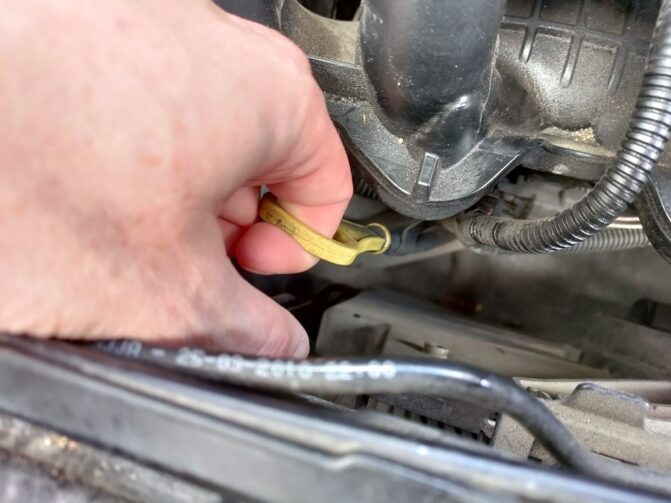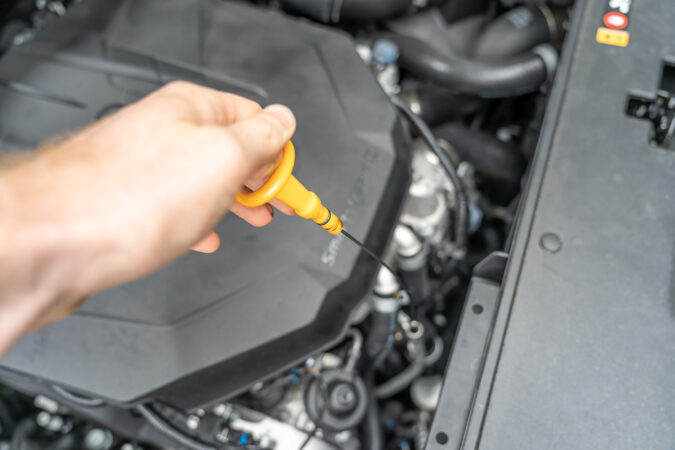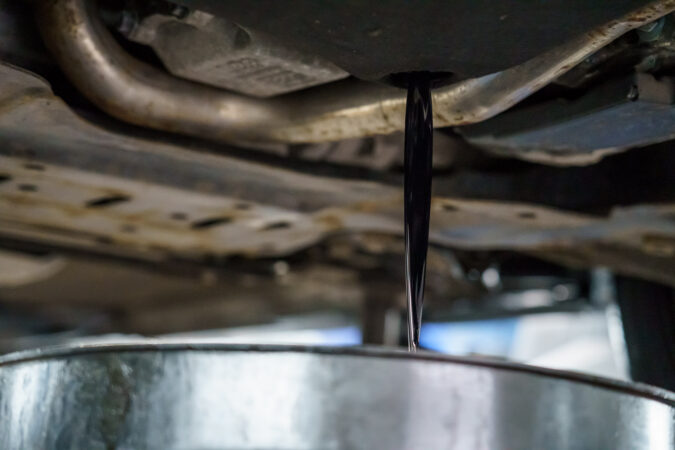If I tell you how many people ruin their transmissions because they are not checking the transmission fluid at all, you will be amazed by the numbers. It is a known fact that one in twenty cars has a bad transmission because the owner doesn’t check the transmission fluid hot or cold.
- What Is a Transmission Fluid?
- Should I Check Hot or Cold?
- How to Check?
- Flush Fluid DIY
- Conclusion
- FAQs
Checking your transmission fluid level will help the longevity of your transmission and will keep you safe from troubles. For example, you can get stranded by the side of the road, if your transmission fails on you all of a sudden. Then you need to call a road rescue service to pick up your car.
Then the car will be towed to the inspection area and they will inspect the damage and the mechanic will start working on your car. This work may take more than two weeks and up to a few months. Depending on where you take your car to. Because some workshops are quicker and some are extremely slow.
If you want to keep it in good condition, always check transmission fluid hot or cold. By following this advice, you can be sure that you will never face one of these issues and that your car will be safe.
In this article, we are going to discuss the transmission fluid and we will learn more about how it behaves in cold and warm temperatures. We are also going to give you some additional maintenance advice. Also, some preventive maintenance that you can do to your car when it comes to these types of issues. Because it’s better to be safe than sorry. If you want to learn more about this, follow along till the end.
Transmission Fluid
Transmission fluid is the fluid that your automatic or manual transmission is using in order to run properly and deliver reliable performance. The fluid moving around inside creates hydraulic pressure within the transmission. This helps in moving up or down the gears.
The proper amount of fluid is necessary for performing this task effectively. That’s why we dedicated a whole article to check transmission fluid hot or cold. We wrote this article only for you to be able to tell, when is the right time to check your transmission fluid. And how you can check the transmission fluid level.
What Is Transmission Fluid
Transmission fluid is also known as Automatic Transmission Fluid (ATF). This fluid is used in automatic transmissions, and also in hydraulic applications. It comes in a special red color. This color is made for the purpose of ATF to be easily distinguishable from other lubricants that are used in cars. Namely, motor oil and brake fluid.
This fluid is also widely used in hydraulic systems and delivers good performance when it comes to machinery. That’s why it is used in automatic transmissions. Because it offers great reliability when it comes to making the transmission work properly.
This fluid is also used in some power-assisted steering systems, and 4WD transfer cases, and is also used in some modern manual transmissions.
When To Check Transmission Fluid
This fluid is claimed that it can last for a lifetime but it is recommended to change it. The biggest reason why it should be changed is because of the metal shavings and other impurities that appear in a transmission over time.
There is plenty of debris that is created during the daily use of the automatic transmission. This debris may block the transmission lines and cause the transmission to shudder. This is a very unpleasant occurrence for many drivers that drive automatic cars, but it’s not something dangerous.
A proper change of the fluid will deliver good performance without any shudders and other issues. It is also recommended to check transmission fluid both hot and cold. Something which we are going to discuss later in this article.
Automatic vs Manual Transmission Fluid
Many people are asking this question and I’m going to answer it for you. Transmission fluid used in manual transmissions and transmission fluid used in automatics is not the same type of fluid. Although these transmissions are doing the same work of shifting gears. There is a big difference. And that is the complexity of these transmissions.
Automatic
An automatic transmission is extremely complex and has plenty of channels where the fluid flows and these channels need to be clean in order to shift the gears properly. This requires a special fluid that is thinner and has less viscosity.
That’s why it uses the ATF fluid as we mentioned above. This fluid can withstand the temperatures and harsh conditions inside the transfer case and will do everything in its power to shift the gears properly and prevent wear and tear.
Manual
Manual transmissions, on the other hand, are not that sensitive to these issues and they can withstand some abuse. Most of them are made to be bulletproof and can run for a lifetime. Except when you connect them to an engine that has a lot of power. In this case, they will not handle the torque and will shatter into pieces.
The oil that these transmissions are using is much thicker and doesn’t require a change until you reach a pretty high mileage. Even though when passing the 100,000-mile mark it is recommended to change this fluid.
This will help with the longevity of the transmission and will greatly improve its performance. As time passes manuals also get more advanced and some of them are used the same ATF fluid as in automatics, and you also need to check transmission fluid hot or cold as well.
Check Transmission Fluid Hot Or Cold
This is a question that many of you are asking. Because fluids are usually checked when the car is cold. For example, if you check the coolant when it’s boiling hot, you can get some third-degree burns on your face or on your hands, so don’t do that.
Oil on the other hand is not that dangerous if you check it when it’s hot. But it’s still not recommended. Because the oil is all over the engine and needs to come down to the oil pan, in order for you to get the proper reading.
The best time to check your transmission fluid is when the transmission is hot. Turn your car on and let it run for some time. This will make the fluids move inside the transmission and be equally applied among the parts. Let your car come up to temperature.
Especially in winter, you do not want to check your transmission when it is really cold outside. Drive your car for a couple of miles before the engine gets up to temperature and then give it a check.
Do You Check Transmission Fluid Hot Or Cold
This is an important step to do. You need to check your transmission fluid when the engine is running. This is important if you have a torque converter automatic transmission in your car. The torque converter is one of the pieces of the puzzle that is called transmission. And the torque converter holds plenty of transmission fluid.
When the torque converter is full of transmission fluid, it means that its fluid level is higher than the one in the oil pan. Because of this, you could end up with a bad reading at the end. It will probably show that your transmission is low on fluid and actually isn’t low at all.
When your engine is working for some time and you shift gears. You can be sure that there is fluid everywhere in the transmission. And the fluid is shared equally among the components.
This is a bit confusing because it’s quite the opposite when you check your regular oil. When you check regular oil, you are waiting for the oil level to come down when the engine is cold. This will help you to get the best reading. But in torque converter automatics, it’s the opposite situation, you should understand this, so it’s never going to confuse you again in the future.
How To Check Transmission Fluid
We explained when it’s best to check transmission fluid hot or cold. Now it’s time to learn how to check the transmission fluid. Although it is a pretty basic procedure. There are still some steps that you need to follow in order to do this procedure as it should. And we shall discuss the next steps in this chapter.
Check Transmission Fluid Hot Or Cold, Step #1: Locate The Transmission Dipstick
The first thing you need to do is to locate the transmission dipstick. This dipstick is very similar to the engine oil dipstick, but the transmission dipstick should be red in color. This color difference is so the owner can tell the difference between these two oil dipsticks.
Check Transmission Fluid Hot Or Cold, Step #2: Pull The Transmission Fluid Dipstick
After you have located the transmission dipstick. Now it is time to pull it out and check the markings. It should clearly say cold and hot. Your ideal transmission fluid level should be close to the upper end of the cold mark when the transmission is cold, and when it’s hot it should be at the upper end of the hot mark. This means that your fluid is topped out and you don’t need any more fluid.
The color of the fluid should be red and the fluid should be clear and runny, not too thick. Now get a clean towel and wipe the end of the dipstick with the towel. Clean off all of the fluid that is on there.
Check Transmission Fluid Hot Or Cold, Step #3: Reinsert The Transmission Oil Dipstick
Reinsert the transmission oil dipstick in its proper position and pull it out again. This is a recommended practice for you to make sure that the readings you get are consistent and you are sure that the level is right.
Check Transmission Fluid Hot Or Cold, Step #4: If It’s Low On Transmission Fluid
If you have a low level of transmission fluid then it’s time to look for a funnel that will fit your fill hole size and pour some ATF inside. Don’t go crazy with it, just add little by little. Check it out every few minutes and make sure that you are at the right spot.
Check Transmission Fluid Hot Or Cold, Step #5: What If My Fluid Isn’t Red
If your fluid isn’t red, that means that your fluid is contaminated or too old. Pull the dipstick out and you will clearly see the color of the fluid. If it’s brownish in color it means that it’s time to change and you need to do your transmission fluid regular service. We are going to explain later on how you can do this job DIY.
Also, see if there is some debris in the oil. This may be a clear sign of a bad transmission that is not regularly serviced. Wipe the dipstick with a clean paper towel and you will clearly see some of the dirt.
How To Check Transmission Fluid Without Dipstick
Yes, you can check the fluid without a dipstick, but you will need to get access from down below. You need to get the bolt out and you will need a special tool to pump out the fluid from the transmission.
Remember that there are two bolts, one on the pan and one on the side. You need to get the bolt on the side. In order to do this in a cleaner way. Unbolt the bolt on the side and pour some ATF with a pump inside the bolt hole. When the fluid starts to come out you mean that you are done and your car doesn’t require any more fluid.
Also, check with your finger the situation of the fluid. Check the color, the viscosity and check if there are any metal particles. As we said, if it’s brownish it means that the transmission fluid needs to be changed soon.
If you see some metal shavings then this is a clear sign that your transmission is bad and you will soon need to replace it. The best advice when you are having a car like this is to flush the old fluid completely and diagnose the rest of the transmission.
What If I Delay My Transmission Service
Transmission fluid should be changed regularly. By changing regularly, I mean every 30,000 miles. This is needed for the transmission to work properly. If you delay your service, it means that the transmission fluid will start to lose its characteristics and thicken up.
This old fluid may lead to premature transmission failure or can cause transmission shudder, or slipping. You do not want these things to happen to you.
The first symptom of a bad transmission is transmission shudder. We wrote about this issue and we concluded that isn’t a big deal, but it’s a clear sign that the transmission is having a bad time and need to be properly checked. By checked I mean that is needed for the service to be done to it. Changing the fluids and maybe pan gasket at the same time.
When the transmission goes towards failure, the clear sign of this is that the transmission is starting to slip. Slipping shouldn’t be something usual to happen on your car, but if it’s happening every now and then. It means that the transmission isn’t working properly and is close to failure.
Slipping usually happens to high mileage transmissions, or transmissions that weren’t serviced regularly.
Servicing the transmission on a regular basis at every 30,000 miles is important. It will help you avoid many possible hurdles, and the transmission will serve you for a long time. Also, by changing your transmission fluid regularly, you will save money in the long run. If you want to learn how this practice is done you should check out our next chapter.
How To Change Automatic Transmission Fluid
If you are interested in mechanical stuff, you will be probably very happy if we tell you that you can change your transmission fluid by yourself. In this chapter, we are going to find out how you can perform this task on your drive.
1. Drain The Fluid
The first thing to do is to remove the transmission fluid dipstick, this is important so the oil will flow better through the drain plug. After you removed the dipstick, start removing the drain plug. An ordinary wrench will do the job. Remove the bolt and let the transmission fluid leak out from the transmission. This may take a couple of minutes, so be patient.
After the transmission is empty of oil. Then comes the next step. And that step is to start unbolting the bolts that hold the transmission fluid pan. Do them one by one and take precautions because in the pan there is still some fluid left. And if you are not careful, you may get a shower of fluid on yourself, so keep this in mind.
After you removed all the bolts start draining all the fluid that is inside of the pan. Take some paper towels and clean the pan really well. Give it a nice scrub to remove all the contaminants. On the bottom, there should be some metal shavings. These should be completely removed when you are done cleaning it.
2. Scrape The Old Gasket Material
Take a scraper and start scraping the pan and the transmission gasket. The old gasket must come off for the new gasket to seal properly. This may take some time and you shouldn’t hurry, take your time.
3. Replace The Filter
The next thing to do is to remove the transmission filter. You will need a wrench to get this job done properly. Unbolt the old filter and mount the new one. After you did this then it’s time for the gasket.
4. Mount The New Gasket
Mount the new gasket properly. So it fits the holes that are meant for the bolts. After you did this job, then mount the oil pan and start tightening up all of the bolts one by one.
When you torque the bolts it is important to do them from the middle and then slowly move right and left. This is needed to make a proper seal, so your transmission doesn’t leak any fluid.
5. Fill The Transmission With New Fluid
After you have done all of this work. Then it’s time to fill up the transmission with brand new ATF fluid (for more context, check out our explainer on will a torque converter fill itself). This fluid should be red and it is really distinguishable by its specific color. After you fill-up the transmission, turn on the car and let it run for a few minutes to idle.
Then put it into drive and see how it shifts. If it doesn’t shift properly, it means that there is low fluid and you need to fill up more. Check on the dipstick and see the fluid level, if there is a lack of fluid then fill it up, and should be ok. Then you are good to go for another 30,000 miles.
If your transmission is bad then it’s the best idea to get a new transmission. There are many places that rebuild these transmissions. But a rebuilt transmission is never the same as a brand-new transmission. You will face the same problems sooner or later. These transmissions are very precise, and if there is a small amount of play, things will not work properly. So, if you have the budget then get a new one.
Check Transmission Fluid Hot Or Cold: In Conclusion…
We may conclude that it is important to check transmission fluid hot or cold. Transmission fluid is important and should be regularly checked and replaced if there is a reason for it. New transmission fluid (for more insight, check out our guide on how do you add transmission fluid and how often does transmission fluid need to be changed) will keep your transmission safe and will serve you for many more miles.
You can do this transmission fluid flush by yourself if you want to, and we explained how you can do it. It is important to follow all the steps involved in this process and you are good to go. Remember, always check transmission fluid hot or cold.
FAQs On Check Transmission Fluid Hot Or Cold
If you’re still curious to learn more about check transmission fluid hot or cold, our FAQs here might help…
What Is ATF
If you’re in the process of getting some new transmission fluid, you might’ve come across the term, ATF. It simply stands for ‘automatic transmission fluid’, which marks it as a transmission fluid that’s been formulated and designed to work well with automatic transmissions. ATF’s mixture and chemical makeup are very different, and in most cases, they can’t be used with a manual transmission. Within an automatic gearbox, ATF functions to lubricate the many moving parts within your car’s transmission. In so doing, it not only preserves the gearbox’s performance but also ensures its longevity and reliable operation. Plus, ATF is used to cool down a transmission, just as how motor oil functions in a car’s engine. Just make sure you pick the right type of ATF for your specific vehicle.
What Color Is Transmission Fluid
The transmission fluid starts off as a bright red, transparent fluid. Over time, that fresh batch of transmission fluid will turn darker and more opaque. Slightly older (but still serviceable) transmission fluid appears as a reddish-brown or light-brown liquid and is more opaque than fresh fluids. Once it fully turns into dark brown or near black, then you’ll need to urgently change your car’s transmission fluid. The primary reason why they get darker is due to a chemical breakdown after constant exposure to immense friction, heat, and pressure within the transmission. Moreover, it also picks up dirt, debris, and other contaminants. Pinkish transmission fluid is much worse, though. This is a sign that coolant or water has mixed in with the transmission; a symptom of catastrophic gearbox failure.
How To Add Transmission Fluid
Before you can start adding any transmission fluid, you’ll first have to find the transmission fluid reservoir. Be sure not to mistake the gearbox fluid dipstick with the motor oil dipstick. There should be a label on the dipstick itself, telling you what it’s connected to. At this point, you can use the dipstick to check both the level and condition of the transmission fluid. Now, before you add the transmission fluid, make sure that you’ve picked the right type of fluid for your car. The owner’s manual should have this detail. To add more fluids, remove the dipstick from before, and add a funnel. Now, slowly pour in the fluids, and stop every once in a while to row through the gears (while idling the engine) to help circulate the fluid. Then, continue until it’s filled.
How To Check Transmission Fluid Dipstick
The transmission fluid dipstick works in a similar way to the engine oil dipstick. Therefore, checking the condition and amount of fluids should be similar, too. First, take out the dipstick and wipe it with a clean rag or paper towel. Now, re-insert it back into the transmission fluid reservoir. Remove it again, and this should give you a clear idea of how your transmission fluid is doing. There should also be distinct markings on the dipstick for reference. For example, you could see that ‘FULL’ has two separate markers, one for when the transmission fluid is warm, and the other for when the fluid is full. Now, if the transmission fluid level doesn’t even reach the warm line (if your owner’s manual states that the engine has to be warmed up beforehand), add some new fluids.
How Much Transmission Fluid Do I Need
If you’re performing any form of maintenance with your car’s gearbox, it’s crucial to understand just how much transmission fluid you’ll need. For most vehicles, the amount ranges from 4 to 17 quarts, though these days, most cars take in around 10 as a general average. The precise amount should be noted somewhere inside your owner’s manual. So, be sure to not overfill or underfill the transmission fluid during a top-up or full fluid flush. Naturally, heavy-duty transmissions will require more transmission fluids to lubricate and cool them compared to more road-going gearboxes. For example, a commercial truck might need as much as 20 quarts of transmission fluid. Meanwhile, a passenger car may take in as little as just 8 to 9 quarts.




